Dating back approximately 2500 years, this ancient Fort in Bihar has extreme historical significance. Ajatshatru Fort was built by King Ajatshatru, the ruler of the Magadha Empire and a contemporary of both Mahavira and Gautam Buddha. The Fort was constructed primarily as a strategic military stronghold to protect the kingdom. It was considered one of the best and finest forts ever built in India, but unfortunately, in the present time, only remains of this architectural beauty can be found. On your next trip to Bihar, make sure to soak in the historical charm of this Fort and embrace the cultural beauty of Bihar.
Ajatshatru Fort Location
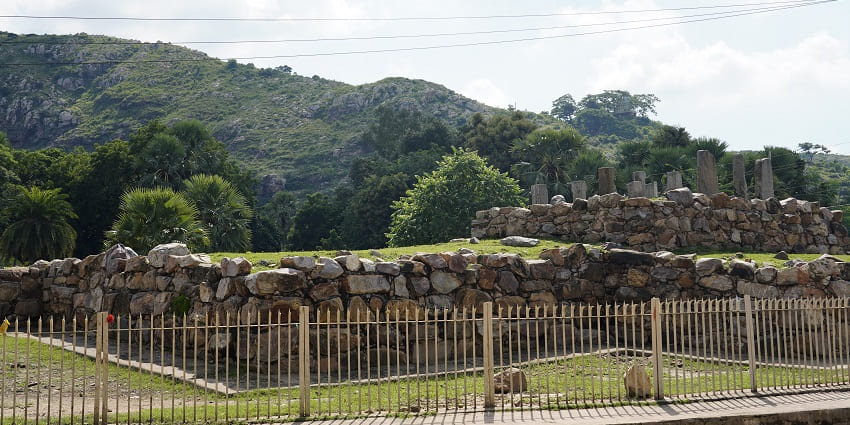
Photo: Amitabha Gupta / Wikimedia Commons
The impressive ruins of this architectural marvel are situated in Rajgir, Bihar. Specifically, you can find them in the Nalanda district, about two kilometres from Rajgir Railway Station. This Fort holds an immense amount of historical significance and is renowned for its architectural features, including a stupa and remnants of its defensive structures.
Suggested Read: Chhapaak Water Park Patna
How To Reach Ajatshatru Fort

Photo: Ram Prasad / Wikimedia Commons
The nearest railway station is the Rajgir Railway Station, approximately 2 kilometres from the Fort. You can reach the Fort by cab or auto-rickshaw from the railway station. It typically takes about 10 minutes to reach by taxi.
10 Places To Visit Around Ajatshatru Fort
Explore the majestic ancient Ajatshatru Fort in Rajgir, a small town in Bihar. Read ahead to find out about other places you can visit in Rajgir.
1. Bimbisara Jail
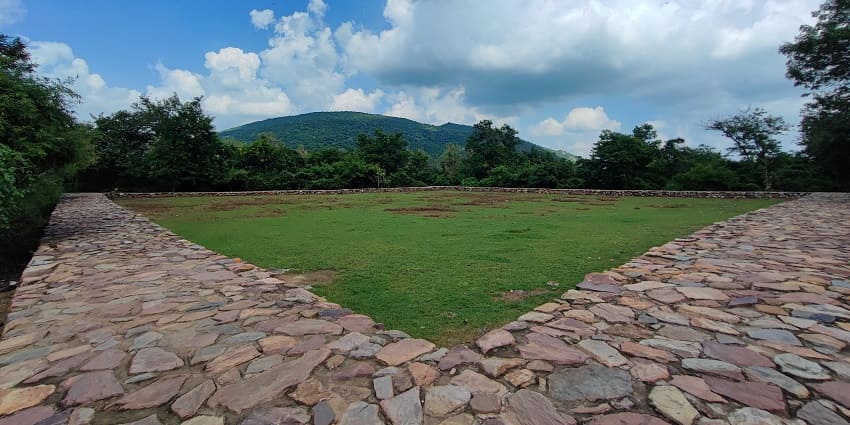
Photo: Sumitsurai / Wikimedia Commons
The Bimbisara Jail holds great historical significance as it is closely linked with King Bimbisara of the Haryanka dynasty who reigned from 543 to 493 BCE. Over time, this site has evolved into a place of pilgrimage, particularly for Buddhists, due to its deep connection with the early history of Buddhism and its location near other essential sites such as Nalanda University and the Vishwa Shanti Stupa.
Best Time To Visit: October to February
Time Required: 1 to 2 hours
Entry Fee: No entry fee
Location: NH 82, Rajgir, Bihar
Distance From The Railway Station: 5 km to Rajgir Railway Station
Suggested Read: Archaeological Museum Bodhgaya
2. Sankhalipi Inscriptions
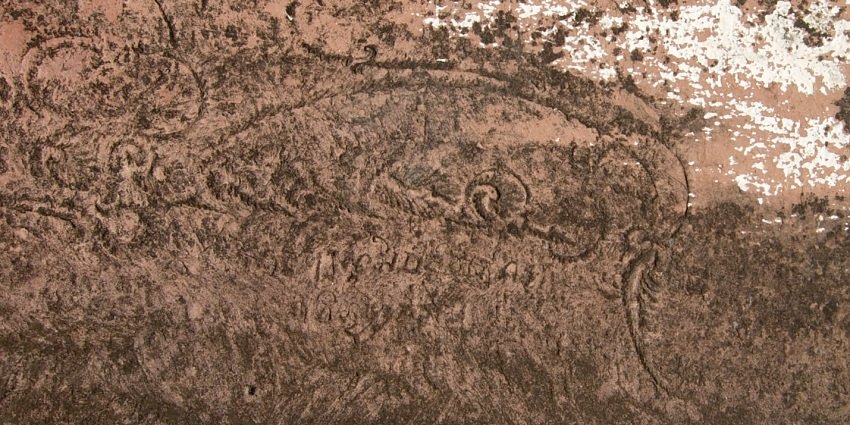
Photo: Zippymarmalade / Wikimedia Commons
The Sankhalipi inscriptions found in the Rajgir region of Bihar hold great historical and cultural significance and are estimated to have been written between the 1st and 5th centuries AD. They have been written in a language which has not yet been deciphered by the archaeologists. These are said to have been written in the Brahmi script. These inscriptions will give you a glimpse into the region’s ancient history.
Best Time To Visit: October to March
Time Required: A few hours
Entry Fee: Entry is free, but you can get a VIP entry by paying Rs. 501
Location: Mundeshwari Dham Road, Bhabua, Paunra Village, Kaimur District, Bihar
Distance From The Railway Station: 5 km to Rajgir Railway Station
3. Vishwa Shanti Stupa
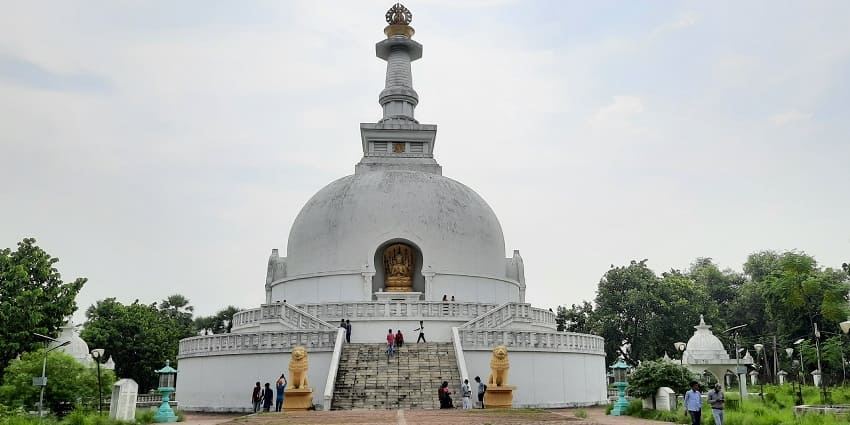
Photo: Jitagna / Wikimedia Commons
The Vishwa Shanti Stupa, known as the World Peace Pagoda, is a magnificent white Buddhist monument. It stands tall at 120 feet with a diameter of 103 feet. The memorial features four gilded statues of Buddha, each representing a significant event in life: birth, enlightenment, preaching, and death. It is easily accessible for all visitors due to its convenient location, just about 8 km from the Rajgir Railway Station.
Best Time To Visit: October to March
Time Required: 1 to 2 hours
Entry Fee: Rs. 80 for the ropeway (round trip)
Location: Vishwa Shanti Stupa Rd, Rajgir, Bihar
Distance From The Railway Station: 8 kilometres from Rajgir Railway Station
Suggested Read: Amazing Hill Stations Near Patna For A Scenic Retreat
4. Saptaparni Caves
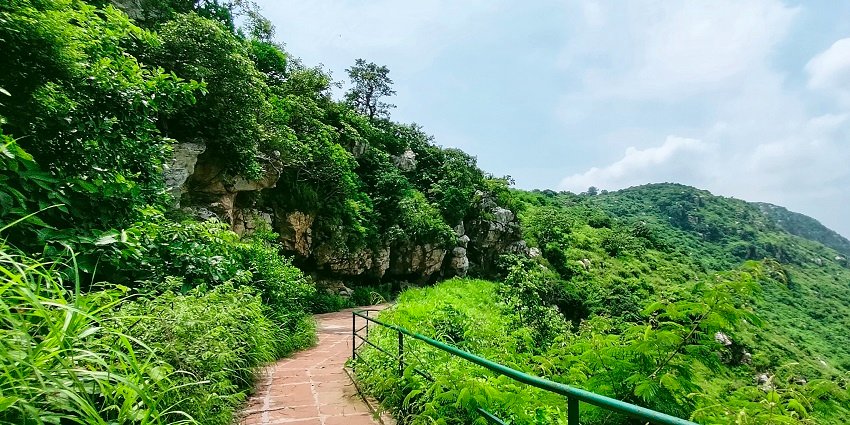
Photo: RohitKrBiharSharif / Wikimedia Commons
Approximately 4 km from Rajgir, you will find the glorious Buddhist Caves, popularly known as the Saptaparni Caves. This location is historically significant as the first-ever Buddhist Council was held here and attended by over 500 monks. This council was paramount for preserving Buddha’s teachings, as he did not write them down himself. They were instead written by his cousin, Ananda and further recited for the disciples by Upali.
Best Time To Visit: October to March
Time Required: 1 to 2 hours
Entry Fee: No entry fee
Location: Vaibhavgiri Hill, Bihar
Distance From The Railway Station: 4 kilometres from Rajgir Railway Station
5. Griddhakuta Hills
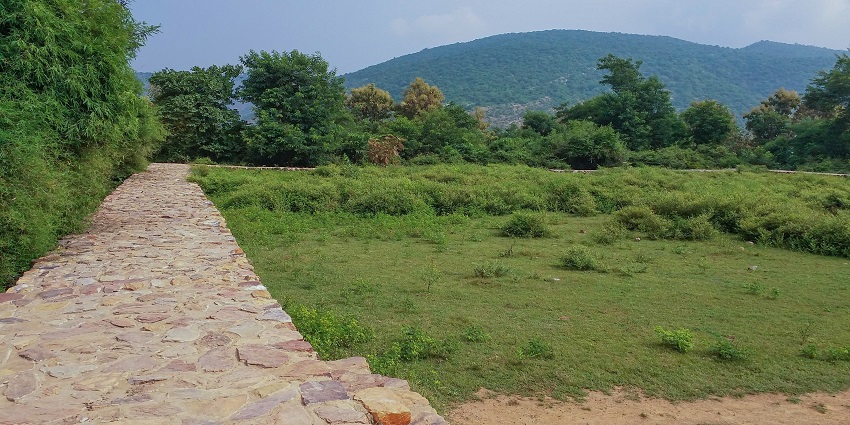
Photo: Parmanu Sarkar / Wikimedia Commons
The Griddhakuta Hills, famously known as the Vulture’s Peak, is a significant attraction for tourists worldwide. This hill is closely associated with Buddhism as it was a favoured retreat for Lord Buddha. He delivered many vital sermons here, including the Lotus Sutra and the Heart Sutra. The hills derive their name from the unique shape that resembles that of a vulture and is frequently mentioned in Buddhist texts.
Best Time To Visit: October to March
Time Required: 1 to 2 hours
Entry Fee: No entry fee, but Rs. 80 for the chairlift service (round trip)
Location: Rajgir, Bihar
Distance From The Railway Station: 8 kilometres from Rajgir Railway Station
Suggested Read: Must-Visit Hill Stations Near Bihar For Your Next Adventure
6. Venuvana
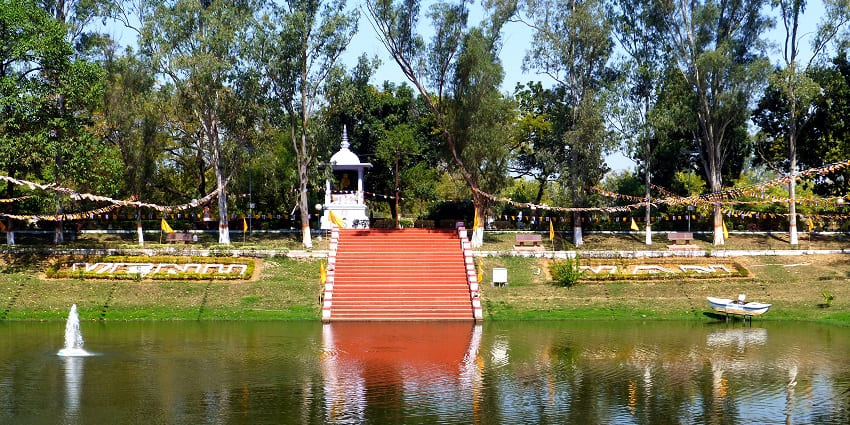
Photo: Photo Dharma / Wikimedia Commons
Venuvana or Bamboo Grove is a renowned tourist destination also located in Rajgir, Bihar. This site is also immensely significant as it was gifted to the Buddha by King Bimbasara. For a long time, this place served as Buddha’s Monastic Residence where he spent a considerable amount of time for meditation and other spiritual practices. Today, the Venuvana stands as a well-maintained park full of serenity and natural beauty.
Best Time To Visit: October to March
Time Required: 1 to 2 hours
Entry Fee: Rs. 20 for Indian Nationals and Rs. 100 for foreigners
Location: Nimal, Rajgir, Bihar
Distance From The Railway Station: 3 km from Rajgir Railway Station
7. Ghora Katora Lake
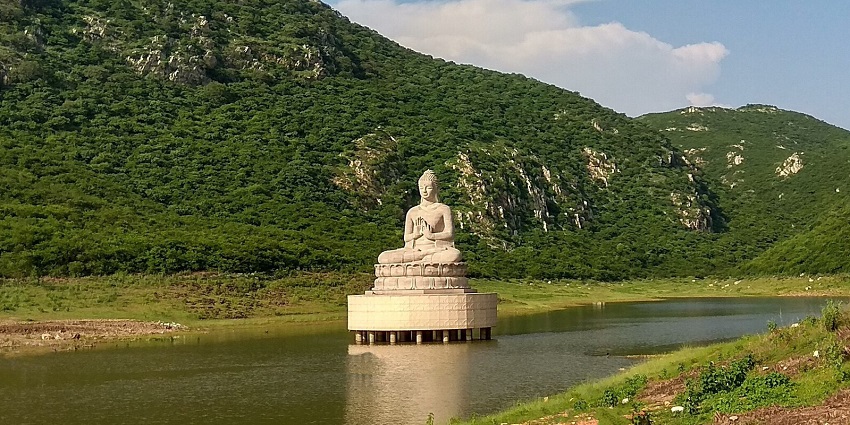
Photo: Chirag1745 / Wikimedia Commons
Ghora Katora, also known as Aimee Maganda, is a natural lake near Rajgir in the Indian state of Bihar. The name “Ghora Katora” means “Horse Bowl” in Hindi. This refers to the lake’s shape, which looks like a horse. The lake is surrounded by mountains on three sides. It is part of the Rajgir Wildlife Sanctuary. This makes it an excellent place for nature lovers and those seeking peace and serenity.
Best Time To Visit: October to March
Time Required: 10 to 11 hours
Entry Fee: No entry fee
Location: 12 km from Rajgir, Bihar
Distance From The Railway Station: 12 km from Rajgir Railway Station
Suggested Read: Dive Into Fun At The Funtasia Water Park In Patna
8. Swarna Bhandar Caves

Photo: Sumitsurai / Wikimedia Commons
The fascinating Swarna Bhandar, or Son Bhandar Caves, are nestled in the enchanting town of Rajgir in Bihar. These incredible artificial caves, thought to originate from the 3rd or 4th century CE, are nestled into the Vaibhar Hills, making them a genuinely significant archaeological site. Local legends suggest that the caves conceal a hidden treasure belonging to King Bimbisara, hence giving its name – “Swarna Bhandar”.
Best Time To Visit: October to March
Time Required: 30 minutes
Entry Fee: Rs. 50 for a guide, free otherwise
Location: Rajgir, Bihar
Distance From The Railway Station: 5 km from Rajgir Railway Station
9. Yesthivana

Photo: Sumitsurai / Wikimedia Commons / Image For Representation Only
Yesthivana, nestled in the heart of Rajgir, Bihar, holds immense historical importance as it has evolved from a simple forest sanctuary into a tranquil haven of nature. This exceptional site is renowned for its deep-rooted association with Buddhism, especially as the sacred ground where Lord Gautam Buddha is believed to have found solace through meditation.
Best Time To Visit: October to March
Time Required: 1 to 2 hours
Entry Fee: No Entry fee
Location: Tapovana in Rajgir, Bihar
Distance From The Railway Station: 4 km from Rajgir Railway Station
Suggested Read: Most Popular Wildlife Sanctuaries In Bihar
10. Makhdum Kund
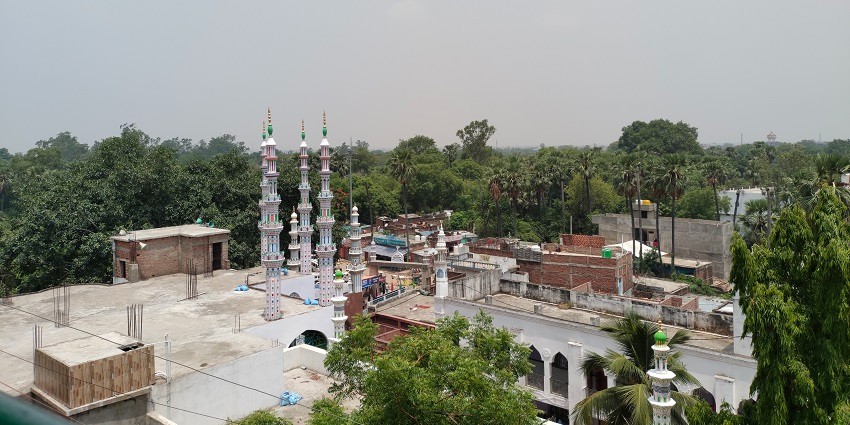
Photo: Botu Yadav / Wikimedia Commons
This Kund is a significant religious site and a renowned tourist destination among Hindus and Muslims. It is also a sacred natural water spring and the Sufi Saint, Makhdhum Shah shrine. You can visit during the major festivals like Eid and Diwali and find this place gathered by large crowds celebrating these festivals with great pomp and show.
Best Time To Visit: March to May (Spring) and September to November (Autumn)
Time Required: 1 to 2 hours
Entry Fee: No entry fee
Location: Rajgir, Bihar
Distance From The Railway Station: 10 km from Rajgir Railway Station
Best Time To Visit
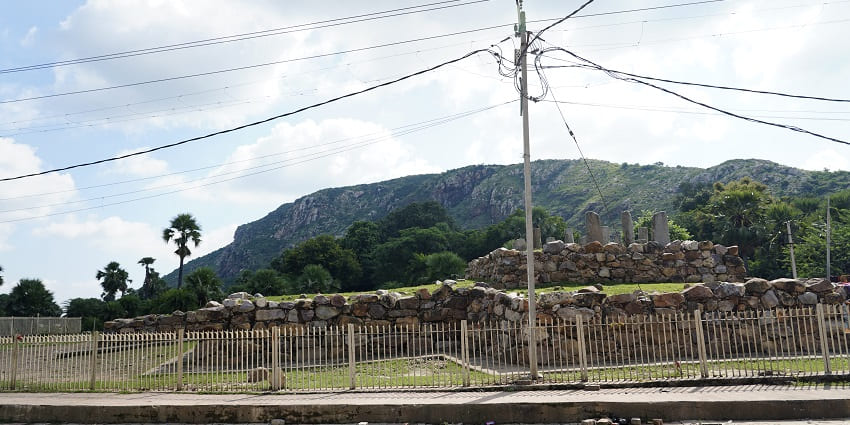
Photo: Amitabha Gupta / Wikimedia Commons
The best time to visit Ajatshatru Fort in Rajgir, a small region of Bihar, is from October to March. Its pleasantly cool weather makes it an ideal time for exploring and enjoying the historical site. The Fort is a significant landmark deeply rooted in history and welcomes visitors all year round, operating from 8 AM to 6 PM daily. Whether you’re a history enthusiast, a culture seeker, or simply looking for a serene escape, visiting Ajatshatru Fort during these months promises a memorable and enriching experience.
Suggested Read: New Year Party In Jamshedpur
Food You Must Try

Photo: MUDITKUMARSINGH252004 / Wikimedia Commons
Bihar boasts a rich culinary heritage with various dishes that reflect its cultural diversity. Some of the must-try dishes of this cuisine include Litti Chokha, an iconic dish featuring wheat flour balls stuffed with roasted chickpea flour and spices and served with mashed eggplants. Another dish you cannot miss is the Dal Peetha, consisting of steamed little balls of heaven. You can also try the infamous Mutton Kebabs if you are a non-veg lover.
The Ajatshatru Fort is a must visit attraction in Bihar for every tourist as it provides a deep insight the vibrant and brave history of Bihar. It remains as a testimony to the past, enticing visitors from all over the world to uncover its mysteries. Book a trip to Bihar with tripXL and make a visit to the Ajatshatru Fort in Rajgir that offers an extraordinary leap into the heart of India’s ancient legacy.
Cover Photo: Amitabha Gupta / Wikimedia Commons


 WhatsApp
WhatsApp
 Twitter
Twitter









